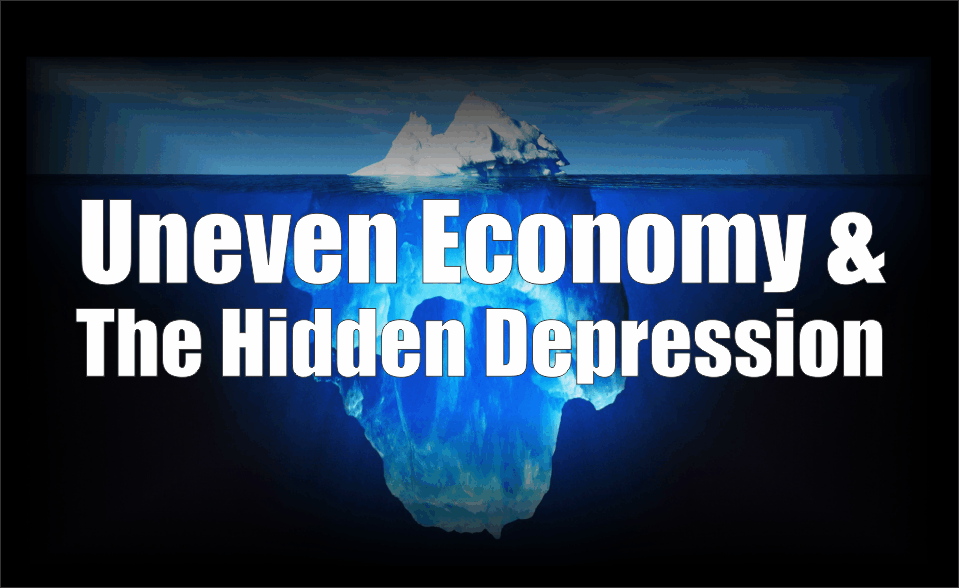Are we in a depression? The question seems absurd. There has been GDP growth since 2009 and some mild inflation to go with it. In fact, this is the second longest economic expansion on record. As Robert Shiller said over the weekend (though in the context of warning against complacency), “[i]f the economy manages to expand for 16 more months, the United States will have set a record.” Unemployment is the lowest in history, nothing like the 17% we had by a U.S. Bureau of Labor Statistics estimate a decade after the stock market crash in 1929 and the average of 18% in the 1930s. House prices have come screaming back across the nation. The stock market has increased by more than 15% annually beginning in 2009. And even middle-class wages have shown signs of picking up lately.
Depression-Era Demographics In Some Exurbs
And yet, even overlooking the opioid epidemic and the 42 million Americans on food stamps (happily down from nearly 48 million in 2013), there are disturbing signs around the country that all is not well. For example, a recent article in the New York Times by Robert Gebeloff focusing on Hunterdon County in New Jersey shows that many suburban and exurban Northeast and Midwest counties have stopped booming. More people are dying than being born or moving in through immigration or migration. Hunterdon County, 60 miles from New York City, is the sixth richest county nationally with a median household income is over $100,000. But young people are having fewer children, and the recession-stalled migration patterns are only resuming in certain parts of the country. According to Geberloff, “Some of the once-fastest-growing counties in the United States are growing no more, and nationwide, the birthrate has dropped to levels not seen since the Great Depression.” Since a recent peak in 2007, lifetime births per woman in the U.S. is down 16%.
Because deaths are outnumbering births in so many outer-ring counties, flummoxing demographers waiting for a trend reversal, migration is crucial. But lower immigration puts stress on Northeastern suburban counties losing population to the South and West. And while more people living in cities may lower long-distance commuting and urban decay, “population stagnation in places that had been growing will most likely bring its own sets of problems, including pressures on real estate values and eventual shrinking of political representation.”
While births have declined, migration within the U.S. has resumed to pre-recession levels. However, the trend if toward Florida, Texas, and Arizona, which have all seen population inflows. Rural parts of the country have been struggling with these demographic problems for a while now, but Gebeloff’s article shows that they are hitting what have been much more well-off areas now. In Hunterdon County, a 460-acre Merck campus sits abandoned, and enrollment in some school districts is down 20%.
Patio Man Still Thrives
But if outer ring Northeastern suburbs are in jeopardy, that’s not the situation everywhere. In 2002, when it looked like exurbia or life in what he called “Sprinkler Cities” was the future, David Brooks wrote a column for the Weekly Standard called “Patio Man and the Sprawl People” partly about how urban types were annexing old line, inner ring suburbs, while more traditional suburbanites were claiming the outer rings where they could enjoy peaceful patios, happy kids, slender friends and “the massive barbecue grill towering over it all.”
Now, it seems, the outer rings are struggling mightily, but perhaps only in the Northeast and Midwest. In other words, Brooks’s 2002 analysis somehow holds up today. This is how he described the trend in defending suburbia, or the movement from old suburbia to new suburbia — “The truth, of course, is that suburbia is not a retreat from gritty American life, it is American life. Already, suburbanites make up about half of the country’s population (while city people make up 28 percent and rural folk make up the rest), and American gets more suburban every year.” And they make up 53% of America now, according to Jed Kolko in a post for the statistically oriented news site, FiveThirtyEight. Moreover, in a 2017 post, Kolko wrote, “The suburbanization of America marches on,” as he noted the fast growth of Southern and Western metro areas, including Cap Coral-Fort Myers, FL, Provo-Orem, UT, and Austin-Round Rock, TX. Kolko also highlighted educated rural areas and the Pacific Northwest as growing regions. Those include Olympia and Spokane in Washington and Eugene and Salem in Oregon. Boise also made his list for growth of metro areas with 250,000 or more people.
The big population losers, unsurprisingly, have been rural areas. And while the “urban revival” is real, according to Kolko, it has mostly been for rich, educated people, in particular hyperurban neighborhoods rather than broad-based return to city living. Patio Man continues to thrive – just not in Hunterdon County, New Jersey.
Overall, the country is hardly in a depression, but things are grimmer than many think in some surprising places.

John Coumarianosis an Analyst for Clarity Financial, LLC, and is a contributing editor to the Real Investment Advice Website. He has been an analyst at Morningstar and a writer for MarketWatch and the Wall Street Journal. Follow John on Twitter.
